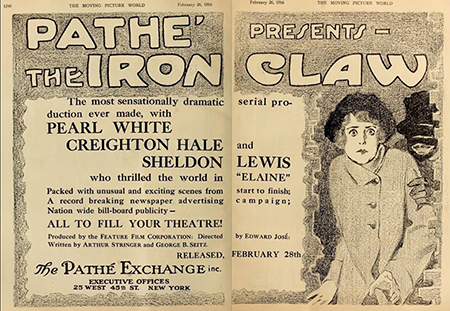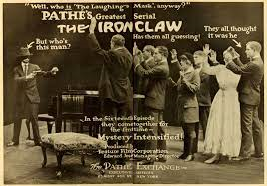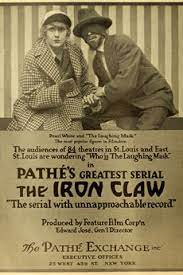I …is for
The Iron Claw
Enoch, though, learning of the infidelity, throws his wife out of their home. As further punishment, he seizes Legar (played by Sheldon Lewis), brands his face, and cuts off his arm, an act that Legar avenges by opening the nearby dikes and flooding the plantation. He also kidnaps the Goldens’ young daughter Margery, whom he raises among his den of thieves and schools in crime. Her criminal career, he believes, will serve as a further humiliation to her father, who over the years has become an even wealthier and more prominent man. Legar’s plan, however, is foiled by the intervention of “The Laughing Mask” (played by Harry Fraser), the nemesis of all criminals, who saves Margery from a nefarious path, rescues her from the attempts on her life, and returns her to her father. Along the way, she becomes romantically linked with the Mask’s secretary, Davy Manley (Creighton Hale), who assists in reconciling her with both of her parents. Each episode ends with the same question: “Who is The Laughing Mask?” His identity is not revealed until the final episode. As Kalton Lahue noted, even in the credits, he appears as “????”
The Iron Claw proved to be a huge success with film audiences. As Ed Hulse notes, it shattered attendance records and reaffirmed Pearl White’s status as the preeminent serial actress—although for the first and only time in her serial career, she shared the spotlight with a secondary character, Harry L. Fraser, the “Laughing Mask,” whose identity is not revealed until the final episode.
Survival Status: Although nineteen of the twenty episodes are presumed lost, one incomplete episode (the seventh, “The Hooded Helper”) survives in the UCLA Film & Television Archive. Chapter 7, Part 1 (1916) – https://www.youtube.com/watch?v=rqFAsGw5gZ4; Chapter 7, Part 2 (1916) – https://www.youtube.com/watch?v=UlZGPINNEyo.
Director: Edward José, George B. Seitz
Release Date: February 27, 1916
Release Company: Pathé Exchange, Inc.
Cast: Pearl White (Margery Golden), Creighton Hale (Davy Manley), Sheldon Lewis (Legar, The Iron Claw), Harry L. Fraser (The Laughing Mask), J. E. Dunn (Enoch Golden), Carey Lee (Mrs. Golden), Clare Miller (Margery as a Child), Henry G. Sell (Wrench), Edward José, E. Cooper Willis, Allan Walker, Bert Gudgeon, George B. Seitz.
Episodes: (two reels each) 1. The Vengeance of Legar. 2. The House of Unhappiness. 3. The Cognac Mask. 4. The Name and the Game. 5. The Incorrigible Captive. 6. The Spotted Warning. 7. The Hooded Helper. 8. The Stroke of Twelve. 9. Arrows of Hate. 10. The Living Dead. 11. The Saving of Dan O’Mara. 12. The Haunted Canvas. 13. The Hidden Face. 14. The Plunge for Life. 15. The Double Resurrection. 16. The Unmasking of Davy. 17. The Vanishing Fakir. 18. The Green-Eyed God. 19. The Cave of Despair. 20. The Triumph of the Laughing Mask.




